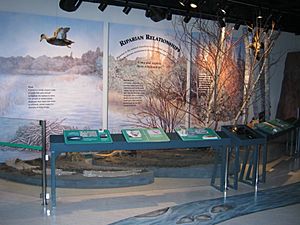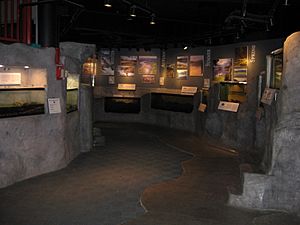Suncor Energy Fluvarium facts for kids
| Date opened | November 1990 |
|---|---|
| Location | St. John's, Newfoundland, Canada |
| Website | www.fluvarium.ca |
The Fluvarium is a special place in St. John's, Newfoundland and Labrador. It's a public center that teaches people about the environment. The Quidi Vidi/Rennie's River Development Foundation runs The Fluvarium. This foundation also manages the Lilypad Childcare Center.
The lowest part of The Fluvarium has nine large windows. These windows let you see right into Nagle's Hill Brook. You can watch brown trout and salmon swimming in their natural home. The center also has many natural water aquariums and terrariums. These show off different fish and amphibian species found in Newfoundland and Labrador.
Contents
The Fluvarium's Story
The Quidi Vidi/Rennie's River Development Foundation (QVRRDF) started in 1985. It is a non-profit group that helps others. Environmentalists and conservationists created it. They wanted to protect and improve Rennie’s River. This river flows through St. John’s and into Quidi Vidi Lake.
The QVRRDF first aimed to clean up the polluted Rennie’s River. They also wanted to build a walking trail along its path. They worked on projects like making the stream banks strong. They also restored the environment and built a fish ladder. Over 7.5 kilometers of walking trails are now along Rennie’s River. These trails include boardwalks and lookout spots.
In 1985, the St. John's City Council approved a plan. The foundation could build an education center at Long Pond. This center would have a special "stream tank." Visitors could look through a glass wall into the river. They would be able to see trout laying their eggs.

By 1987, the QVRRDF started teaching school children. Their programs helped kids understand the ecosystem of the river. The foundation spent most of 1988 getting money to build The Fluvarium. In June 1988, Prince Edward helped start the building work.
The Fluvarium opened to the public in November 1990. Its goal was to teach people, especially kids, about watersheds. It also taught how to care for them properly. The Princess Anne officially opened it on July 2, 1991. The opening included showing a special plaque and a tour of the building.
Amazing Exhibits
Water: Past, Present, and Future
The second floor has exhibits about freshwater environments. You can see Nagle's Hill Brook from here. There are fun, interactive displays about water and glaciations. You can also learn about wetlands, riparian zones, and water monitoring.
The Fluvarium's Underwater View
The main Fluvarium level has a wide view through nine big windows. These windows look into Nagle's Hill Brook. This brook is a small stream that flows into Rennie's River. It starts 3 kilometers north of The Fluvarium. The brook was moved so visitors could see it through the "windows on a stream." This lets you explore river life and its ecosystem.
The windows show different parts of a river. You can see deep pools, shallow pools, and fast-flowing riffle areas. Most of the fish you see are brown trout. This type of fish came to Newfoundland in 1884. Fish can enter and leave this part of the brook using a fish ladder. In the fall, you can watch brown trout build their nests, called redds. They also lay their eggs in the riffle areas.
The center also has many aquariums. They are filled with stream water from Nagle's Hill Brook. These tanks have typical freshwater fish and amphibians from Newfoundland and Labrador. You might see Atlantic salmon, American eels, Arctic char, wood frogs, and green frogs.
Working Together
Research Projects
The QVRRDF started its first research project at The Fluvarium in March 1992. They studied how to make rainbow trout flesh more colorful. They worked with the Newfoundland and Labrador Institute of Fisheries and Marine Technology.
From 1995 to 2002, The Fluvarium helped with a salmon restocking program. They worked with the Department of Fisheries and Oceans. Salmon eggs were kept at The Fluvarium. Each year, about 8000 young salmon were released into the Rennie's, Waterford, and Virginia Rivers.
In 1999, salmon were found in a fish trap at Quidi Vidi Lake. People thought they were from the first group of young salmon released in 1995. These were the first salmon seen in the rivers since the 1930s!
Salmon Education Program
The Fluvarium still helps with Atlantic salmon restocking. They work with the Atlantic Salmon Federation's Fish/Friends program. Each spring, The Suncor Energy Fluvarium gives about 1600 salmon eggs to schools. The schools raise the eggs in special classroom incubators. Later in the spring, classes visit The Suncor Energy Fluvarium. They release the young salmon into Nagle's Hill Brook.
The Duck Race Fun
The Annual Rennie's River Duck Race is a popular event. It helps the Quidi Vidi / Rennie's River Development Foundation raise money. This money supports their environmental projects.
This race has been a yearly tradition since 1988. Many people come to watch up to 4800 yellow rubber ducks. These "sponsored" ducks float down the Rennie's River through the city. They race to the finish line! You can visit The Fluvarium's website to learn more about this fun event.
Images for kids










